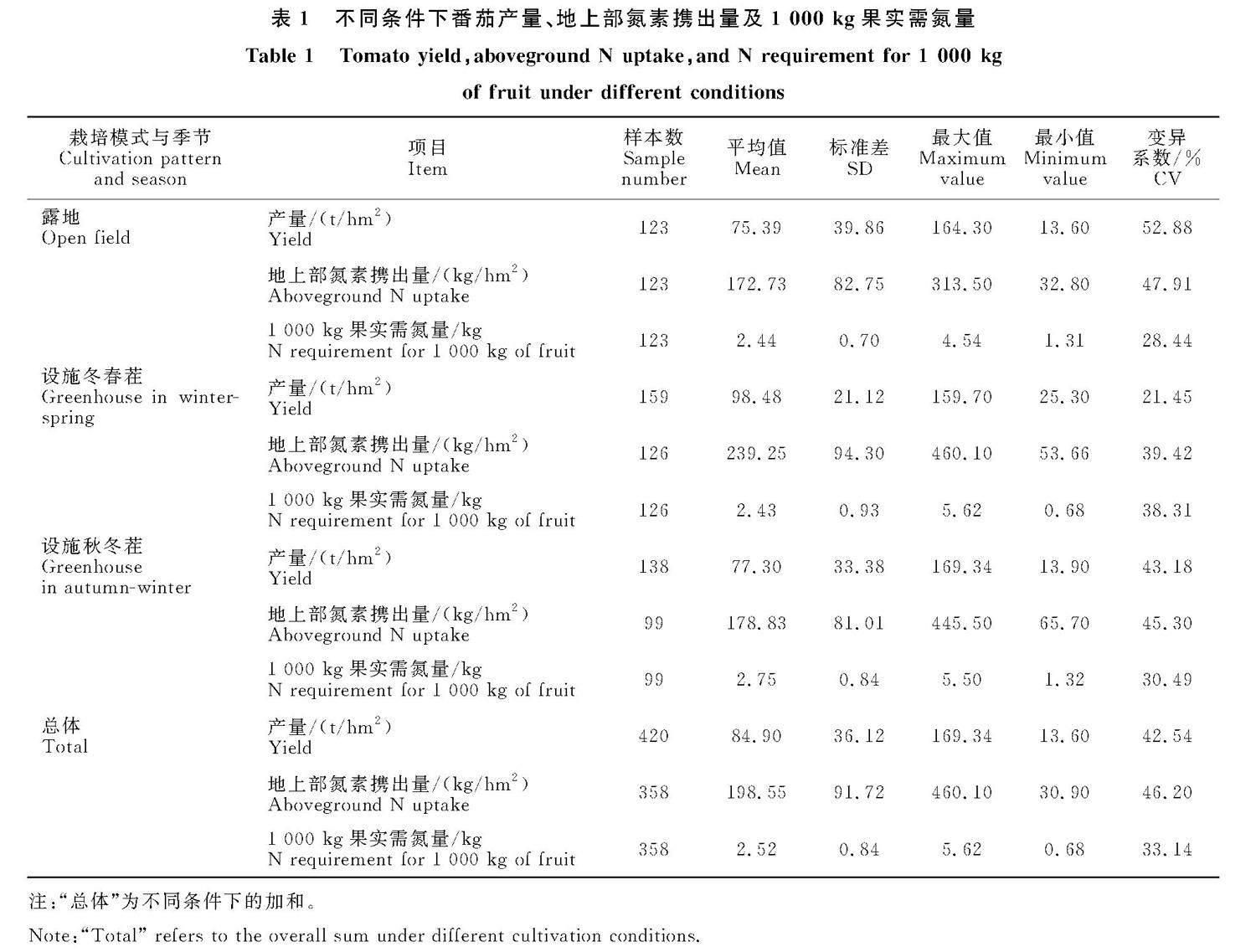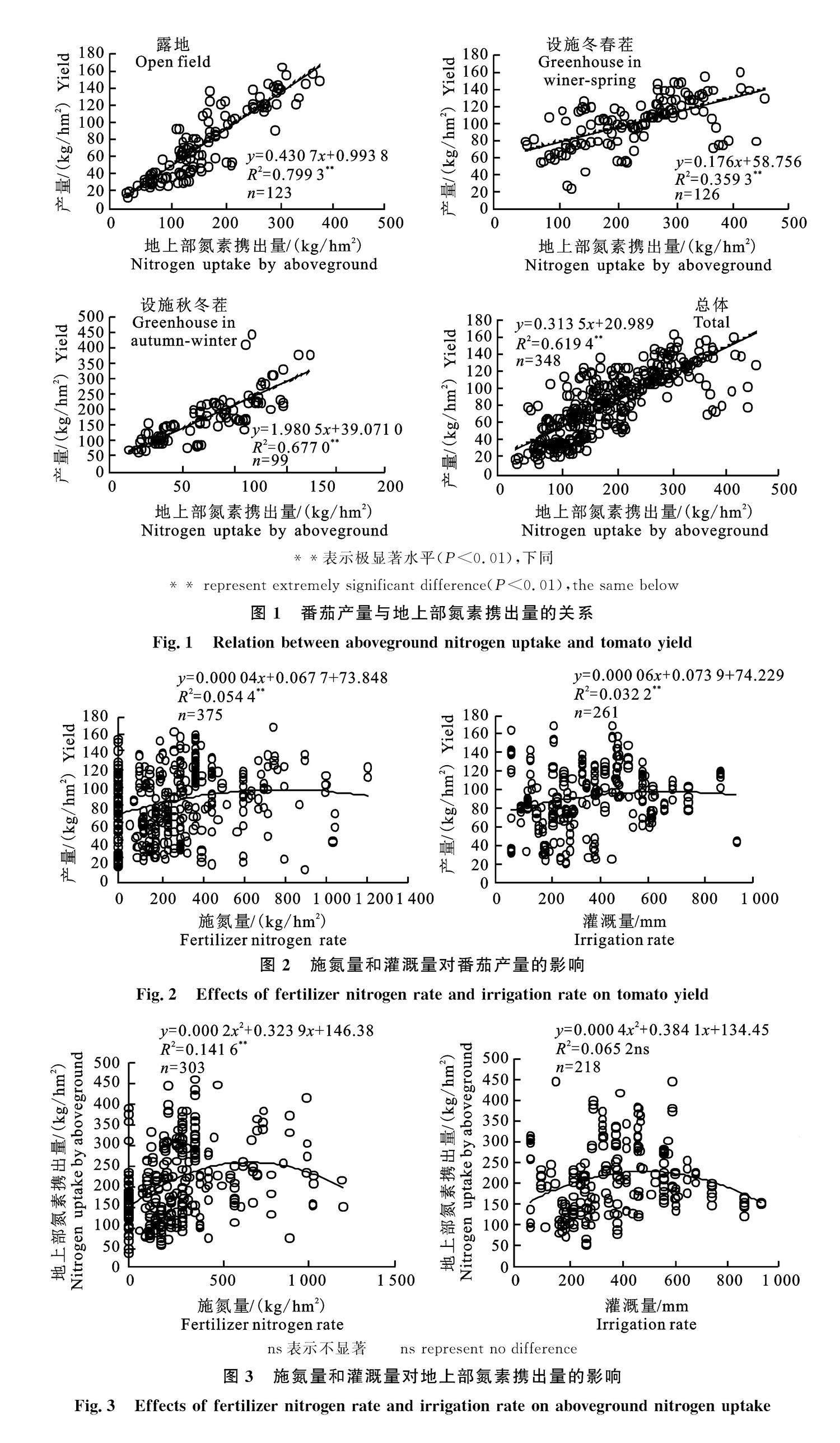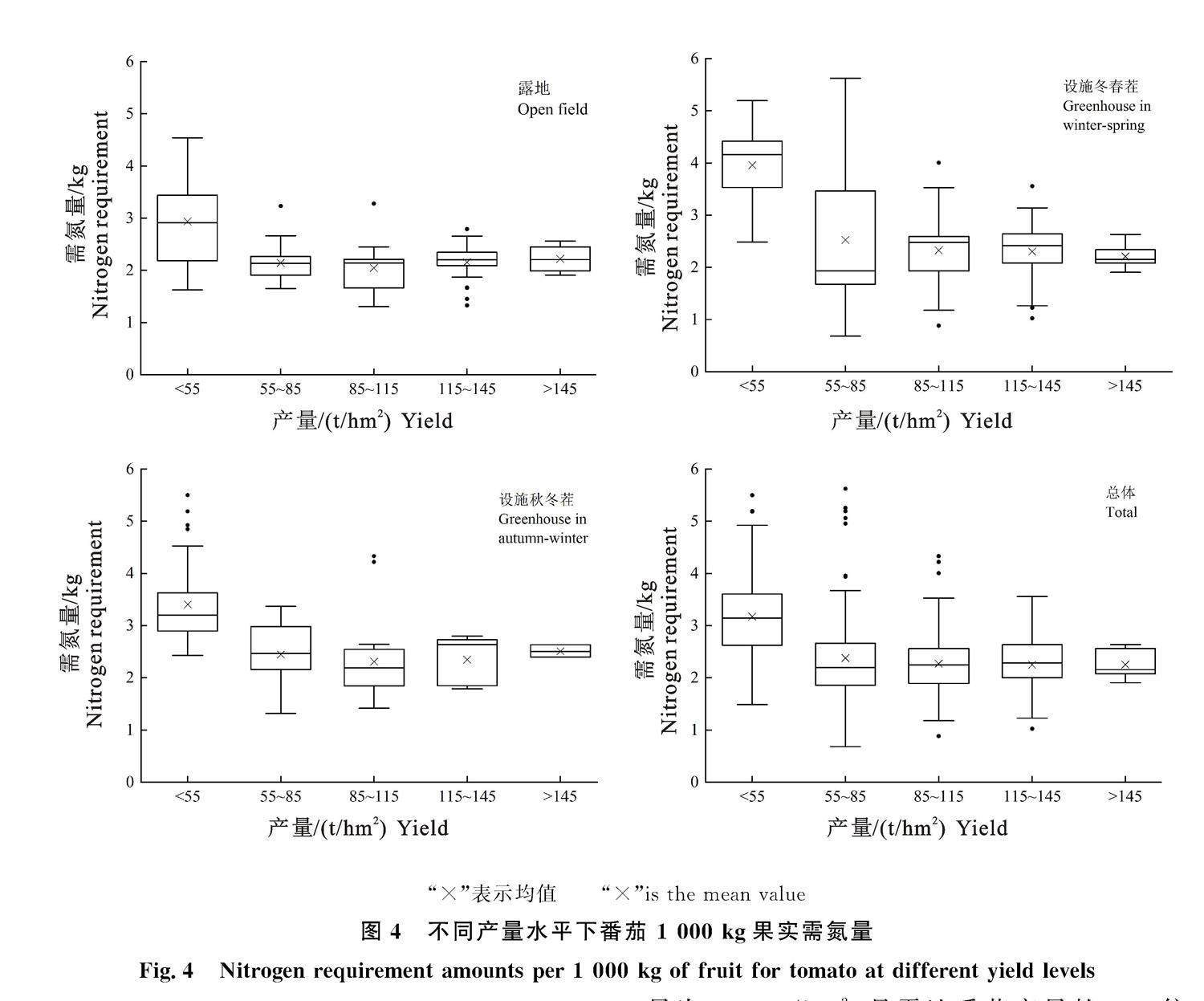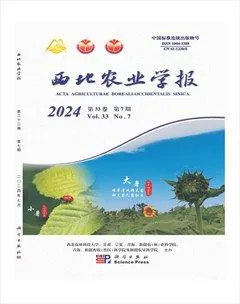不同栽培方式番茄氮素吸收量及理论施氮量
邓小芳 程于真 杨明霞 陈竹君 周建斌



doi:10.7606/j.issn.1004-1389.2024.07.012
https://doi.org/10.7606/j.issn.1004-1389.2024.07.012
收稿日期:2023-06-26 修回日期:2023-10-13
基金项目:山东省重点研发计划(2023TZXD028);国家重点研发计划(2017YFD0200106)。
第一作者:邓小芳,女,副教授,硕士生导师,研究方向为设施蔬菜体系氮的去向和调控。E-mail:dxf@nwafu.edu.cn
通信作者:周建斌,男,教授,博士生导师,研究方向为土壤-植物系统氮素循环及调控。E-mail:jbzhou@nwsuaf.edu.cn
摘 要 研究不同栽培方式及茬口下番茄产量、地上部氮素吸收量和生产1 000 kg果实需氮量的差异,根据目标产量给出田块尺度理论氮素推荐量,为不同栽培条件下番茄氮肥的合理施肥提供理论依据与技术指导。收集国内外有关番茄氮素利用的文献43篇,统计分析露地、设施冬春茬和设施秋冬茬栽培条件下番茄的产量、地上部氮素携出量和形成1 000 kg果实需氮量;根据不同产量水平,计算1 000 kg番茄果实需氮量的变化;用理论施氮量的方法计算不同目标产量下番茄的理论施氮量。分析表明,露地、设施冬春茬和设施秋冬茬番茄的产量、地上部氮素携出量和形成1 000 kg果实需氮量存在明显差异。设施冬春茬番茄的产量最高为98.5 t/hm2(n=159),是露地和设施秋冬茬番茄产量的1.3倍。设施冬春茬地上部氮素携出量为239.3 kg/hm2 (n=126),高于露地和设施秋冬茬。与产量和地上部氮素携出量不同,设施秋冬茬形成1 000 kg番茄果实的需氮量最高,为2.75 kg(n=99),设施冬春茬和露地相接近,分别为2.43 kg(n=126)和2.44 kg (n=123)。番茄产量和地上部氮素携出量之间有显著的线性相关性,番茄产量随地上部氮素携出量的增加而显著增加。番茄产量和地上部氮素携出量受水肥投入影响,灌溉量对番茄产量的影响极显著,随灌溉量增加产量先缓慢上升后下降,但灌溉量对番茄地上部无显著影响。番茄产量水平在<55、55~85、85~115、 115~145、>145 t/hm2时,生产1 000 kg果实的需氮量分别为3.17、2.38、2.27、2.25和2.25 kg。番茄形成1 000 kg果实的需氮量随着产量水平的增加反而呈现降低的趋势。理论施氮量的计算简单易推广。番茄目标产量在50~150 t/hm2时,露地、设施冬春茬和设施秋冬茬番茄的理论施氮量范围分别在182~547、183~549和206~619 kg/hm2,露地番茄和设施冬春茬番茄的理论推荐施氮量相近。不同栽培形式和岔口对番茄产量和氮素吸收特性均会产生影响。
关键词 番茄;产量;地上部氮素携出量;理论施氮量
番茄(Solanum lycopersicum Mill.)是全世界栽培最为普遍的果菜之一,它不仅适应范围广,产量高,且富含多种维生素和其他营养成分,因此具有很高的营养和经济价值[1]。在蔬菜生产中,氮素对促进其生长和增产的效果最为显著[2];同时,番茄由于果实采收期长、产量高、土壤养分移出量大,需要充分的氮素供给。所以,生产中为保证番茄产量菜农往往过量施用氮肥,这不仅影响番茄生长、产量和品质,而且导致植株病害加剧和环境污染等一系列问题[3-4]。因此,确定合理施氮量是获得作物高产、保持土壤肥力和减少施氮引起环境污染的关键[5]。
露地和设施是番茄栽培的两种主要方式。不同栽培方式下番茄的产量差异显著,Maureira等[6]采用模拟的方法得出,美国华盛顿州设施番茄产量是露地的6.4倍。设施栽培番茄根据栽培时间分为冬春茬和秋冬茬。Wu等[7]研究发现,冬春茬番茄产量显著高于相同处理下秋冬茬产量;但Du等[8]研究发现,相同处理下冬春茬和秋冬茬产量没有显著差异。不同栽培条件及茬口产量的差异,必定会导致氮素吸收量的不同。
氮肥施用量的多少对番茄产量、品质、氮素利用率等均有显著影响,合理的施氮量对番茄栽培非常关键[9]。姜慧敏等[10]在山东寿光进行调查,发现每季设施番茄化肥氮的施用量远高于每季地上部的氮素携出量,化肥氮投入高达1 000 kg/hm2,当季氮肥利用率低于10%。闵炬等[11]研究发现,农民习惯施氮量(300 kg/hm2)导致大棚番茄有减产趋势,而减氮20%~40%不仅可以保证产量,还可以保证果实品质。Sun等[12]利用EU-Rotate N模型得出设施秋冬茬番茄最佳施氮量为150 kg/hm2,冬春茬番茄为250 kg/hm2。王新等[13]对番茄地上部生物量、氮素累积的变化进行动态模拟,发现北疆地区加工番茄滴灌栽培的理论适宜施氮量为349~382 kg/hm2。可见,不同研究对番茄适宜施氮量的研究结果差异较大。
因此,确定不同区域不同类型番茄合理施氮量仍是一个值得研究的问题[14]。常用的方法包括田间试验法、土壤和植株测定法等,但这些方法存在工作量大、成本高等问题,不适合大面积应用推广,尤其对于小农户[15]。基于此,Ju等[16]提出了确定作物理论施氮量的方法,该方法用作物根区氮肥、土壤氮和作物吸收氮三者的数量关系来确定施氮量,根据农田秸秆还田的生产实际,推导出推荐施氮量约等于作物地上部吸氮量。生产单位果实需氮量是该法确定氮肥适宜用量的关键,而目前关于番茄吸氮规律及生产单位果实需氮量虽开展了不少研究,但多为小样本的田间小区试验,对于不同区域间大尺度、大样本数量的研究缺乏系统报道。因此,本文旨在通过收集大量有关番茄氮素利用的文献资料和田间试验数据进行系统分析,探明不同栽培方式及不同茬口下番茄产量、地上部氮素携出量和生产1 000 kg果实需氮量的差异,明确不同产量水平下1 000 kg果实需氮量的变化特征;根据目标产量给出田块尺度氮肥理论推荐量,以期为指导番茄合理施肥和提高氮肥利用效率提供理论依据与科学参考。
1 材料与方法
1.1 数据来源
本研究在中国知网和维普中文文献数据库及Web of Science英文文献数据库进行文献搜集。以“番茄” “产量” “氮素” “氮肥吸收利用”及其组合为主要关键词进行文献检索。为了确保分析的准确性,遵循以下4个标准对收集文献进行筛选分析:1)试验方式为田间试验;2)数据需包含产量、施氮量、氮素携出量、灌溉量等至少2个指标,且有明确的标准差或者重复值,重复数≥3;3)试验地、试验作物、生产管理等基本信息清晰;4)不同文献中的相同试验数据只录入1次。
基于以上标准本文收集了43篇国内外有关番茄氮素吸收利用的文献资料。番茄品种有‘粉安娜‘布鲁特斯‘金鹏 ‘农大等多种,均为大果蔬菜番茄。将研究对象分为露地和设施(温室、大棚)2种栽培方式,由于设施蔬菜种植制度一般为一年两茬制,因此根据茬口不同将设施栽培番茄分为冬春茬和秋冬茬。冬春茬种植一般在l月下旬至2月上旬移栽,6月中上旬拉秧,秋冬茬种植一般在8月中旬移栽,翌年1月中旬拉秧。研究样本包括得到产量数据为420个、氮肥施用量375个、灌溉量261个和植株地上部氮积累量358个。
1.2 数据提取
如果文献中含有样本数、均值及标准差,则直接进行数据的提取;如果文献中不直接含有标准差,但处理有多个重复时,则提取数据之后,计算出均值和标准差。文献中如果只有图,没有表,则使用 GetData 软件进行数据提取。
1.3 理论施氮量的计算
巨晓棠[14]认为在长期秸秆还田的情况下,在确定了百千克收获物需氮量(N100,kg)后,推荐施氮量(Nfert,kg/hm2)是目标产量(Y,kg/hm2)的唯一函数,即理论施氮量Nfert≈Y/100×N100。但是番茄一般很少直接进行秸秆还田,因此,番茄的理论推荐量应等于上述结果加上扣除果实之外的地上部氮素携出量。综合各种文献报道及笔者试验结果[8],扣除果实之外的地上部氮素携出量约占地上部总氮素携出量的50%,即可得出番茄的理论施氮量Nfert≈Y/1 000×N1 000+Y1 000×N1 000×50%≈Y/1 000×N1 000(1+50%),其中N1 000为形成1 000 kg番茄果实的需氮量。
1.4 数据分析
采用Microsoft Office Excel 2016 软件进行基础数据整理和图表制作,SPSS 21.0进行统计分析,用Duncans检验(α=0.05)进行多重比较。
2 结果与分析
2.1 番茄产量和氮素吸收量
由表1可知,大田试验条件下番茄平均产量为84.9 t/hm2(n=420),但不同栽培条件下番茄产量差异较大。设施冬春茬番茄产量最高为 98.48 t/hm2(n=159),是露地和设施秋冬茬番茄产量的1.3倍。露地和设施秋冬茬的番茄产量接近,分别是75.39 t/hm2(n=123)和77.3 t/hm2 (n=138)。不同栽培条件下番茄的地上部氮素携出量同样也存在差异,平均地上部氮素携出量为198.55 kg/hm2(n=358),其中设冬春茬的地上部氮素携出量最高为239.25 kg/hm2 (n=126),露地最低为172.73 kg/hm2(n=123),相差 66.52 kg/hm2。与产量和地上部氮素携出量不同的是,设施秋冬茬形成1 000 kg番茄果实的需氮量最高,为2.75 kg(n=99),设施冬春茬和露地相接近,分别为2.43 kg(n=126)和2.44 kg(n=123),较设施秋冬茬低。设施秋冬茬形成1 000 kg果实所需的氮素量是露地和设施冬春茬的 1.1倍。综上可知,设施冬春茬的番茄产量和地上部氮素携出量较露地和设施秋冬茬高,设施冬春茬形成1 000 kg番茄果实高于设施冬春茬和露地。
2.2 番茄产量与地上部氮素携出量的关系
对地上部氮素携出量和番茄产量进行相关性分析,由图1可知,番茄产量随地上部氮素携出量的增加而增加,呈显著的线性关系。番茄产量和地上部氮素携出量的相关性系数分别为0.799、0.36和0.677,均达极显著水平。总体样点的相关函数表达式为y =0.314x + 20.989(x表示地上部氮素携出量,y为产量),R2为0.619,达到极显著水平(P<0.01)。
2.3 水肥投入与番茄产量、地上部氮素携出量的关系
分别以氮肥施用量和灌溉量作为自变量,以产量和番茄地上部氮素携出量作为因变量,分析其相关性。发现氮肥施用量和灌溉量对番茄产量的影响均达极显著水平(P<0.01);氮肥施用量对番茄地上部氮素携出量的影响达极显著水平(P<0.01),但灌溉量对其无显著影响。
番茄产量随施氮量的增加,呈现出先缓慢上升后再下降的趋势(图2),由此可知,在一定范围内增施氮肥有利于促进果实增产,但其施用量过高或过低均会导致负效应。番茄产量随灌溉量的变化与氮肥施用量有类似的规律,这表明过度干旱或过度灌溉都会导致番茄产量下降。番茄地上部氮素携出量随施氮量的增加,呈开口向下的抛物线形状(图3)。因此,在一定范围内氮肥的增施能促进作物对氮素的吸收利用,但施用量过高同样也会降低地上部对氮素的吸收。
2.4 番茄氮素吸收特征及其产量效应
将番茄产量分为<55、55~85、85~115、 115~145和>145 t/hm2 5个水平组,进一步研究形成1 000 kg果实需氮量与番茄产量水平的关系。5个番茄产量组由低到高的平均产量分别是35.3 t/hm2(n=89)、70.5 t/hm2(n=93)、102.1 t/hm2(n=85)、127.2 t/hm2(n=70) 和>152.1 t/hm2(n=11)。
露地番茄在5个产量水平分组下,生产1 000 kg番茄的需氮量从低至高依次为2.94(n=48)、2.14(n=30)、2.05(n=16)、2.15(n=25)和2.22 kg(n=4);设施冬春茬番茄生产1 000 kg果实的需氮量依次为3.96(n=5)、2.53(n=35)、2.33 (n=45)、2.30(n=35)和2.20 kg(n=6);设施秋冬茬番茄分别为3.41(n=36)、2.44(n=28)、 2.31(n=24)、2.34(n=10)和2.63 kg(n=1)(图4)。综上可知,5个番茄产量分组由低到高形成 1 000 kg果实需氮量分别为3.17、2.38、2.27、 2.25和2.25 kg。因此,番茄需氮量随产量水平的提高呈逐渐递减趋势。
2.5 番茄的理论施氮量
根据本试验上述研究结果,露地、设施冬春茬和设施秋冬茬番茄形成1 000 kg果实需氮量平均为2.43 kg、2.44 kg和2.75 kg。根据番茄的理论施氮量算式,可以求出不同栽培条件下不同目标产量的理论施氮量(表2)。由表2可知,番茄目标产量在50~150 t/hm2时,露地、设施冬春茬和设施秋冬茬番茄的理论施氮量为182~547 kg/hm2、183~549 kg/hm2和206~619 kg/hm2,露地番茄和设施冬春茬番茄的理论推荐施氮量相近。
3 讨 论
不同栽培模式会显著影响作物的产量。石会娟等[17]研究表明,河北省设施番茄产量是露地番茄产量的1.4倍。本研究中,设施番茄的平均产量为87.9 t/hm2,是露地番茄产量的1.2倍。因此,从番茄产量来看,设施栽培模式优于露地栽培。相比露地栽培,设施栽培模式拥有更适宜作物生长的不同于大田的小气候环境[18-19],且配套设施更好。种植茬口对设施番茄产量和地上部氮
素携出量的影响存在差异。赵云霞等[20]选取9个番茄品种进行试验,发现设施冬春茬番茄产量为秋冬茬的1.1倍~1.8倍;高方胜等[21]也研究表明,设施冬春茬的番茄单株产量为1.22 kg,较设施秋冬茬提高40.23%,且冬春茬番茄的全株氮素吸收积累量和吸收速率显著高于秋冬茬。本研究结果类似,番茄平均产量和地上部氮素携出量设施冬春茬分别是设施秋冬茬的1.27倍和 1.34倍。但Du等[8]研究发现,日光温室冬春茬和秋冬茬番茄产量无显著差异。因为本研究收集了大量数据,所以在绝大多数情况下,设施冬春茬的产量要高于秋冬茬。冬春茬番茄所处的温度和光照条件较好,栽培期间外界气温和日平均光照强度不断上升,适宜番茄生长;而秋冬茬番茄所处的温度和光照条件的变化与冬春茬变化相反,后期果实的膨大受到影响,最终影响产量。
施肥和灌溉是限制作物增产的两大重要因子[22],同时二者存在明显的交互效应[23],适宜的水分条件会增强养分的质流和扩散,保障土壤养分离子向作物根系的迁移,施肥反过来又会影响作物对水分的吸收、转运和利用[24]。李建明等[25]研究发现番茄产量随施肥和水分的变化均呈开口向下的抛物线形状,这说明过度干旱或过度滞水均会加剧作物的减产,同样在一定范围内增加施肥量有利于产量的提高,但施肥量太少或太多同样均会造成减产。这与本研究结果一致。养分吸收是干物质形成和累积的基础,干物质和养分累积是产量形成的前提[26],本研究显示,氮素携出量与产量之间呈显著正相关关系;番茄地上部氮素携出量受施氮量的显著影响,在一定范围内植株地上部氮素携出量随施氮量的增大而增大,持续增大反而降低地上部氮素携出量。
已有诸多研究资料表明,每形成1 000 kg的番茄果实,地上部氮素吸收量为1.38~2.93 kg[27-29]。本研究表明,番茄形成1 000 kg果实所需氮量随产量水平的提高逐渐下降,平均为2.52 kg,产量在<55、55~85、85~115、115~145和>145 t/hm2时,形成1 000 kg 果实的氮吸收量分别为3.17 kg(n=89)、2.38 kg(n=93)、2.27 kg(n=85)、2.25 kg(n=70)和2.25 kg(n=11),这与黄倩楠等[30]研究小麦需氮量随产量变化的规律类似。随着番茄的生长发育,果实吸氮量随产量增加而增加,但到果实膨大期后茎和叶中的部分氮发生转移,供应番茄果实的生长[31],故产量的增加幅度大于地上部吸氮量的增加幅度,导致需氮量降低。露地、设施冬春茬和设施秋冬茬番茄形成1 000 kg果实的需氮量分别为2.44、2.43 和2.75 kg。这是因为不同栽培模式和茬口的温度、水分、土壤等环境条件和田间管理技术不同,导致其存在差异。这说明在番茄实际生产中,适宜施氮量的确定要考虑产量、土壤养分和农艺措施等综合因素。
目前对番茄最佳施氮量的研究大部分是通过设置氮素梯度试验,这对中国小农户经营而言,操作复杂且成本较高,实用性差。所以作物理论施氮量的方法较简单易于接受,只需基层推广人员将简单的算式和系数告诉农户,农户通过口算就能得知自己田块的氮肥施用量,因为农户对自己田块的目标产量是相当清楚的[14]。王新等[13]根据Quad-ratic模型得出,北疆地区露地加工番茄理论产量在114~120 t/hm2时,理论适宜施氮量在349~382 kg/hm2;本研究应用理论施氮量,露地番茄目标产量在110~120 t/hm2时,相应理论推荐施氮量在401~431 kg/hm2。可以看出高于Quad-ratic模型所得的施氮量,这可能是因为Quad-ratic 模型未考虑土壤本底氮的消耗。但远低于农户习惯施氮量,所以理论施氮量方法是值得推荐的简单易行的方法。
4 结 论
通过文献搜集与数据分析得到冬春茬的设施栽培模式番茄产量最高,设施秋茬和露地番茄产量较设施冬春茬低,但其两者之间产量相近。露地、设施冬春茬和设施秋冬茬番茄形成1 000 kg果实需氮量分别为2.44、2.43、2.75 kg。番茄目标产量在50~150 t/hm2时,露地、设施冬春茬和设施秋冬茬番茄的理论施氮量分别为182~547、183~549和206~619 kg/hm2。在番茄生产实践中,理论施氮量是一种可推荐的简单易行的方法。根据不同栽培模式和目标产量,可很快的算出合理施氮量,最终实现氮肥的合理施用。
参考文献 Reference:
[1]
TOOR R K,SAVAGE G P,HEEB A.Influence of different types of fertilizers on the major antioxidant components of tomatoes[J].Journal of Food Composition and Analysis,2006,19(1):20-27.
[2]ELIA A,CONVERSA G.Agronomic and physiological responses of a tomato crop to nitrogen input[J].European Journal of Agronomy,2012,40:64-74.
[3]李天来,杨丽娟.作物连作障碍的克服——难解的问题[J].中国农业科学,2016,49(5):916-918.
LI T L,YANG L J.Overcoming continuous cropping obstacles—The difficult problem[J].Scientia Agricultura Sinica,2016,49(5):916-918.
[4]高峻岭,宋朝玉,王玉军,等.施肥对青岛市设施蔬菜产量、净产值及土壤环境的影响[J].中国生态农业学报,2011, 19(6):1261-1267.
GAO J L,SONG ZH Y,WANG Y J,et al.Effect of fertilization on yield,net income and soil environment in Qingdao protected vegetable production systems[J].Chinese Journal of Eco-Agriculture,2011,19(6):1261-1267.
[5]巨晓棠.氮肥有效率的概念及意义—兼论对传统氮肥利用率的理解误区[J].土壤学报,2014,51(5):921-933.
JU X T.The concept and meanings of nitrogen fertilizer availability ratio ― Discussing misunderstanding of traditional nitrogen use efficiency[J].Acta Pedologica Sinica,2014,51(5):921-933.
[6]MAUREIRA F,RAJAGOPALAN K,STOCKLE C O. Evaluating tomato production in open-field and high-tech greenhouse systems[J].Journal of Cleaner Production,2022(337):130459.
[7]WU Y,YAN S C,FAN J L,et al.Combined application of soluble organic and chemical fertilizers in drip fertigation improves nitrogen use efficiency and enhances tomato yield and quality[J].Journal of the Science of Food and Agriculture,2020,100(15):5422-5433.
[8]DU Y D,ZHANG Q,CUI B J,et al.Aerated irrigation improves tomato yield and nitrogen use efficiency while reducing nitrogen application rate[J].Agricultural Water Management,2020,235:1-11.https://doi.org/10.16/j.agwat.2020.106152.
[9]寇长林,骆晓声,巨晓棠.优化施氮对设施番茄土壤硝态氮残留及土壤氮平衡的影响[J].植物营养与肥料学报,2021,27(5):837-848.
KOU CH L,LUO X SH,JU X T.Effects of optimal nitrogen fertilization on N balance and nitrate-N accumulation in greenhouse tomato fields[J].Journal of Plant Nutrition and Fertilizers,2021,27(5):837-848.
[10] 姜慧敏,张建峰,杨俊诚,等.施氮模式对番茄氮素吸收利用及土壤硝态氮累积的影响[J].农业环境科学学报,2009,28(12):2623-2630.
JIANG H M,ZHANG J F,YANG J CH,et al.Effects of models of N application on greenhouse tomato N uptake,utilization and soil NO3--N accumulation[J].Journal of Agro-Environment Science,2009,28(12):2623-2630.
[11]闵 炬,施卫明.不同施氮量对太湖地区大棚蔬菜产量、氮肥利用率及品质的影响[J].植物营养与肥料学报,2009,15(1):151-157.
MIN J,SHI W M.Effects of different N rates on the yield,N use efficiency and fruit quality of vegetables cultivated in plastic greenhouse in Taihu lake region[J].Plant Nutrition and Fertilizer Science,2009,15(1):151-157.
[12]SUN Y,HU K L,FAN Z B,et al.Simulating the fate of nitrogen and optimizing water and nitrogen management of greenhouse tomato in North China using the EU-Rotate N model[J].Agricultural Water Management,2013,128:72-84.
[13]王 新,马富裕,刁 明,等.不同施氮水平下加工番茄植株生长和氮素积累与利用率的动态模拟[J].应用生态学报,2014,25(4):1043-1050.
WANG X,MA F Y,DIAO M,et al.Dynamics simulation on plant growth,N accumulation and utilization of processing tomato at different N fertilization rates[J].Chinese Journal of Applied Ecology,2014,25(4):1043-1050.
[14]巨晓棠.理论施氮量的改进及验证—兼论确定作物氮肥推荐量的方法[J].土壤学报,2015,52(2):249-261.
JU X T.Improvement and validation of theoretical N rate (TNR)—Discussing the methods for N Fertilizer recommendation[J].Acta Pedologica Sinica,2015,52(2):249-261.
[15]YIN Y L,ZHAO R F,YANG Y,et al.A steady-state N balance approach for sustainable smallholder farming.EU-Rotate N model[J].PNAS,2021,118(39):e2106576118.
[16]JU X T,CHRISTIE P.Calculation of theoretical nitrogen rate for simple nitrogen recommendations in intensive cropping systems:a case study on the North China Plain[J].Field Crops Research,2011,124:450-458.
[17]石会娟,王 哲.河北省露地及设施西红柿生产收益研究[J].农村经济与科技,2016,27(16):37-38.
SHI H J,WANG ZH.Study on the income of tomato production in open land and facilities in Hebei Province[J].Rural Economy and Technology,2016,27(16):37-38.
[18]蔡祖聪.我国设施栽培养分管理中待解的科学和技术问题[J].土壤学报,2019,56(1):36-43.
CAI Z C.Scientific and technological issues of nutrient management under greenhouse cultivation in China[J].Acta Pedologica Sinica,2019,56(1):36-43.
[19]姜玲玲,刘 静,赵同科,等.有机无机配施对番茄产量和品质影响的Meta分析[J].植物营养与肥料学报,2019, 25(4):601-610.
JIANG L L,LIU J,ZHAO T K,et al.Meta-analysis of combinative application of organic and inorganic fertilizers on effect of yield and qualities of tomato[J].Journal of Plant Nutrition and Fertilizers,2019,25(4):601-610.
[20]赵云霞,利继东,崔静英,等.栽培季节对不同品系番茄生长和产量构成的影响[J].安徽农业科学,2016,44(2) :38-40.
ZHAO Y X,LI J D,CUI J Y,et al.Effect of cultivation season on different strains tomato growth and yield components[J].Journal of Anhui Agricultural Sciences,2016,44(2):38-40.
[21]高方胜,徐 坤.土壤水分对不同季节番茄产量及氮磷钾吸收分配特性的影响[J].核农学报,2014,28(9):1722-1727.
GAO F SH,XU K.Effect of soil water content on yield,absorption and distribution of N,P and K in tomato with different cultivation seasons[J].Journal of Nuclear Agricultural Sciences,2014,28(9):1722-1727.
[22]LING H,LV H F,BATCHELOR W D,et al.Simulating nitrate and DON leaching to optimize water and N management practices for greenhouse vegetable production systems[J].Agricultural Water Management,2020,241:1-11.http://doi:10.1016/j.agwat.2020.106377.
[23]BADR M A,ABOUHUSSEIN S D,ELTOHAMY W A.Tomato yield,nitrogen uptake and water use efficiency as affected by planting geometry and level of nitrogen in an arid region[J].Agricultural Water Management,2016,169:90-97.
[24]袁宇霞,张富仓,张 燕,等.滴灌施肥灌水下限和施肥量对温室番茄生长、产量和生理特性的影响[J].干旱地区农业研究,2013,31(1):76-83.
YUAN Y X,ZHANG F C,ZHANG Y,et al.Effects of irrigation threshold and fertilization on growth,yield and physiological properties of fertigated tomato in greenhouse[J].Agricultural Research in the Arid Areas,2013, 31(1):76-83.
[25]李建明,潘铜华,王玲慧,等.水肥耦合对番茄光合、产量及水分利用效率的影响[J].农业工程学报,2014,30(10):82-90.
LI J M,PAN T H,WANG L H,et al.Effects of water-fertilizer coupling on tomato photosynthesis,yield and water use efficiency[J].Transactions of the Chinese Society of Agricultural Engineering,2014,30(10):82-90.
[26]邢英英,张富仓,张 燕,等.滴灌施肥水肥耦合对温室番茄产量、品质和水氮利用的影响[J].中国农业科学,2015,48(4):713-726.
XING Y Y,ZHANG F C,ZHANG Y,et al.Effects of water-fertilizer coupling on tomato photosynthesis,yield and water use efficiency[J].Scientia Agricultura Sinica,2015,48(4):713-726.
[27]贺会强.日光温室冬春茬番茄施肥指标的研究[D].陕西杨凌:西北农林科技大学,2012.
HE H Q.Studies on fertilization index for tomato cultivation in solar-greenhouse under spring growing season[D].Yangling Shaanxi: Northwest A&F University,2012.
[28]朱 娜.番茄测土配方施肥技术探讨[D].江苏扬州:扬州大学,2014.
ZHU N.Research of the formula fertilization by soil testing on tomato[D].Yangzhou Jiangsu:Yangzhou University,2014.
[29]吴建繁,王运华,贺建德,等.京郊保护地番茄氮磷钾肥料效应及其吸收分配规律[J].植物营养与肥料学报,2000, 6(4):409-416.
WU J F,WANG Y H,HE J D,et al.Study on the effect,absorption and distribution of NPK on tomato in greenhouse of Beijing suburbs[J].Journal of Plant Nutrition and Fertilizers,2000,6(4):409-416.
[30]黄倩楠,王朝辉,黄婷苗,等.中国主要麦区农户小麦氮磷钾养分需求与产量的关系[J].中国农业科学,2018, 51(14):2722-2734.
HUANG Q N,WANG ZH H,HUANG T M,et al.Relationships of N,P and K requirement to wheat grain yield of farmers in major wheat production regions of China[J].Scientia Agricultura Sinica,2018,51(14):2722-2734.
[31]齐红岩,李天来,郭 泳,等.日光温室番茄长季节栽培条件下植株营养元素吸收特性的研究[J].沈阳农业大学学报,2000,31(1):64-67.
QI H Y,LI T L,GUO Y,et al.Nutrients absorption properties of tomato in long-season cultivation in solar greenhouse[J].Journal of Shenyang Agricultural University,2000,31(1):64-67.
Nitrogen Uptake and Theoretical Nitrogen Application Rate of Tomato under Different Cultivation Conditions
DENG Xiaofang,CHENG Yuzhen,YANG Mingxia,CHEN Zhujun and ZHOU Jianbin
(College of Natural Resources and Environment,Northwest A&F University/Key Laboratory of Plant Nutrition and
Agro-Environment in Northwest China,Ministry of Agriculture and Rural Affairs,Yangling Shaanxi 712100,China)
Abstract This study investigated variations in tomato yield,aboveground nitrogen (N) uptake,and N requirement for producing 1 000 kg of fruit under different cultivation methods and stubble.Furthermore,this study aimed to provide theoretical N recommendations at the field scale, guided by the target yield.The results of this study will contribute to the development of a theoretical framework,and provide technical recommendations for the optimal fertilization of tomatoes under diverse cultivation conditions.A comprehensive review of 43 domestic and international literature sources on N utilization was conducted.The compiled data covered various cultivation scenarios,including open-field culture,greenhouse cultivation during the winter-spring,and autumn-winter seasons.A statistical analysis was performed to assess tomato plant yield,aboveground N uptake,and nitrogen requirements for 1 000 kg of tomato fruit.The change in the N requirement for 1 000 kg of tomato fruit at different yield levels was calculated.The theoretical N rate method was used to calculate the theoretical N application rate for tomatoes under different target yields.The highest yield of tomato in greenhouse cultivation during winter-spring reached 98.5 t/hm2 (n=159),which was 1.3 times higher than that in open field and greenhouse cultivation during autumn-winter.The aboveground nitrogen uptake of the winter-spring stubble was 239.3 kg/hm2 (n=126),which was higher than that of the open-field and the autumn-winter stubble.The highest N requirement for producing 1 000 kg of tomato fruit was 2.75 kg in greenhouse cultivation during autumn-winter.The winter-spring stubble of the greenhouse cultivation were close to that of open field,with requirement of 2.43 kg and 2.44 kg,respectively,both of which were lower than the autumn-winter stubble of the greenhouse cultivation.Aboveground N uptake increased significantly with increasing tomato yields,and a significant linear relationship was observed between them.The application of water and fertilizer affected tomato yield and aboveground N uptake.The study found a strong relationship between irrigation volume and tomato yield.As the quantity of irrigation increased,tomato yield first showed a gradual increase,followed by a decline.However,the amount of irrigation did not significantly affect the aboveground nitrogen uptake.The N requirement for 1 000 kg of tomato fruit decreased with the increase of yield level,being 3.17,2.38, 2.27, 2.25 and 2.25 kg for tomato yields <55,55-85,85-115,115-145,>145 t/hm2,respectively.The calculation of the theoretical N application was easily generalized.For target tomato yield between 50-150 t/hm2,the theoretical N application rates for open field tomato,greenhouse cultivation during winter-spring tomato,and greenhouse cultivation during autumn-winter tomatoes ranged from 182-547, 183-549 to 206-619 kg/hm2,respectively.The theoretical recommended N application rates for open field tomatoes and greenhouse cultivation during winter-spring tomatoes were found to be similar.The yield and N uptake characteristics of tomatoes were affected by different cultivation forms and planting seasons.Considering the target yield of tomato and the N requirement for 1 000 kg of fruit under different cultivation,it becomes possible to calculate the nitrogen content necessary for producing 1 000 kg of fruit.This calculation helps determine the appropriate nitrogen fertilizer application rate for tomatoes under different cultivation conditions,thereby offering valuable guidance for optimizing nitrogen fertilizer utilization in tomato cultivation.
Key words Tomato; Yield; Aboveground N uptake; Theoretical nitrogen rate
Received 2023-06-26 Returned 2023-10-13
Foundation item the Key R&D Program of Shandong Prince(No.2023TZXD028); the National Key R&D Program of China (No.2017YFD0200106).
First author DENG Xiaofang,female,associate professor,master supervisor.Research area:nitrogen destination and control in vegetable system.E-mail:dxf@nwafu.edu.cn
Corresponding author ZHOU Jianbin,male,professor,doctoral supervisor.Research area:utilization and management of nutrient resources.E-mail:jbzhou@nwsuaf.edu.cn
(责任编辑:史亚歌 Responsible editor:SHI Yage)

